98 Search Results for data collection
February 19, 2017
by Carole Zangari -

Hope you had a sweet week of AAC love! Here are some posts you may have missed. Monday: PrAACtical Resources: Downloadable AAC Posters Tuesday: Happy Valentine’s Day! Wednesday: Video of the Week: Using Structure to Support Participation Thursday: Data Collection for the Beginning AAC User: Essential Things to Measure to Expedite Progress
February 2, 2017
by Carole Zangari -

Helping people become effective communicators through AAC involves having intimate knowledge about them, their experiences, what they like and do, where they go, and how they feel, among other things. In short, we’re privy to information from and about our clients that can be sensitive. There are several privacy implications for our work with AAC learners, some of which is governed by laws and regulations. In this post, we explore some of those issues. Vocabulary and Message Selection Until our clients are fully literate or competent with a linguistically robust AAC system, they depend on others to select the words, phrases, sentences, and questions that populate their communication devices/aids. This means that we have to obtain intimate knowledge of their lives in order to know what they might want to say and find ways to provide access to those words. We sometimes end up knowing things about our clients and their... [Read More...]
January 26, 2017
by Carole Zangari -
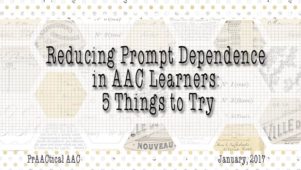
“He knows what to do. He just doesn’t do it.” “He’s prompt-dependent. How can I get him to use AAC on his own?” “I love his strong-willed nature, but it works against him sometimes. He doesn’t initiate.” If any of these remarks sound familiar, it may be time to think about alternative approaches to build independent communication. Here are a few things to try with AAC users who’ve learned to wait for support before communicating. Exaggerate the pause time: Many of our AAC learners need at least 5 seconds of pause time after a communication opportunity presents itself. This helps them process the experience, organize their thoughts, decide on a response, and then begin to execute that response. Sometimes, though, we work with people who’ve learned that if they just wait, the communication partner will start to help (whether or not they need it). We can sometimes nudge the learner... [Read More...]
December 22, 2016
by Carole Zangari -
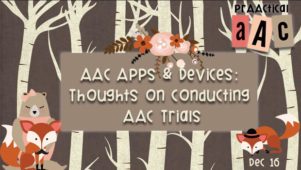
In an earlier post, we talked about why a period of trial use with multiple AAC devices and/or apps is an important part of the process of selecting a communication tool. As with test driving a car prior to purchasing it, giving clients an opportunity to use the AAC options that have the features they need allows us to better determine whether it is likely to meet their needs and expectations. Few of us would purchase a car without taking it out for a spin. It makes a lot of sense, but what does the ‘test drive’ equivalent look like in AAC? What makes for a fair and reasonable period of trial use when we’re trying out an SGD or AAC app? Here are some thoughts to get us started. Clarify the primary purpose of the trial, which generally involves determining a) whether the person can actually utilize it, and... [Read More...]
August 31, 2016
by Carole Zangari -
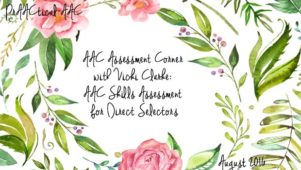
The month of August is almost over and we’ve saved the best for last. The month wouldn’t seem complete without hearing more of Vicki Clarke’s ideas on AAC assessment. In addition to many other things, Vicki’s practice, Dynamic Therapy Associates, does 50+ of these evaluations each year, both in the clinic and in school settings. In this post, Vicki shares some thoughts on assessing the AAC skills of people who use direct selection. As always, she packs in a lot of information and generously provides the protocol and data collection forms that she uses. You can explore some of her previous posts in the AAC Assessment Corner series here. * ::::::::::::::::::::::::::::::::::::::::::::::::::::::::::::::::::::::::::::::::::::::::::::::::::: AAC Skills Assessment for Direct Selectors I spent the morning with a great group of students at the University of Georgia (UGA) in Dr. Satterfield’s AAC class. I was asked to talk with them about AAC assessment with an emphasis on... [Read More...]
August 18, 2015
by Carole Zangari -

Classrooms are busy places, and sometimes the AAC gets lost in the hustle and bustle. If you’re interested in boosting AAC use during the school day, here are some things to try. Co-teach or teach a lesson: Think it’s easy to model AAC and elicit it at the same time you’re providing whole class or small group instruction? Try it. Better yet, make teaching a co-teaching a lesson in the classroom part of your regular service delivery schedule. It’s scary at first, but hang in there. You’ll gain valuable information about what it takes to make AAC successful under real-world conditions, and gain credibility with the rest of the team. Offer support: “What can I do to make it easier for classroom staff to implement the AAC strategies?” “Ms. Aide, how can I help you use the device more when you talk to Shayna?” Make the data available to everyone... [Read More...]
February 2, 2015
by Carole Zangari -

The ATIA 2015 Conference was one of the best ever, with strong presentations, a vibrant exhibit area, lots of fun social events, and great networking opportunities. There were lots of highlights, but here are a few prAACtical ‘finds’ that might interest you. Spanish version of Word Power: The language options for AAC devices and apps keeps getting better and better! I love that you can purchase the Spanish pageset/voices, then configure Word Power so that the user can toggle back and forth between English and Spanish user profiles. Once configured, your client can independently go from English to Spanish words, phrases, grammar, and voices (and vice versa). This will help our prAACtical friends who speak English in school and Spanish at home. I explored it on the Nova Chat from Saltillo but there is also a Spanish add-on to the TouchChat app. Book Bridge: We’re all looking for better ways to make... [Read More...]
October 30, 2014
by Carole Zangari -
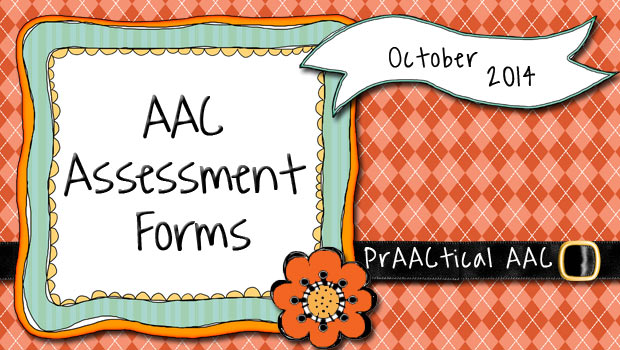
One of the challenging things about teaching graduate student SLPs to do AAC assessments is that there is no single, comprehensive protocol to cover the needs of all types of clients. We’ve started a collection of forms and thought some of you might find them helpful. If you know of others, please get in touch so we can add to the list. That way we’ll have them all in one place. Intake and General AAC Assessment AAC Assessment Protocol: Gail Van Tatenhove AAC Checklist and Rubric: Tufte AAC Intervention Rubric: Angela Standridge, Texas Region 4 Education Service Center Adult Pre-Assessment (Acquired Disabilities): Gail Van Tatenhove Adult Pre-Assessment (Congenital Disabilities): Gail Van Tatenhove Bloom and Lahey-Early Communicative Forms and Functions: Exceptional Children Division, NC Department of Public Instruction Dynamic Assistive Technology Evaluation (DATE) Collaborative Worksheet: Texas AT Network Needs Assessment: Gail Van Tatenhove Pediatric Pre-Assessment: Gail Van Tatenhove Picture Assessment: Gail... [Read More...]
January 6, 2014
by Carole Zangari -
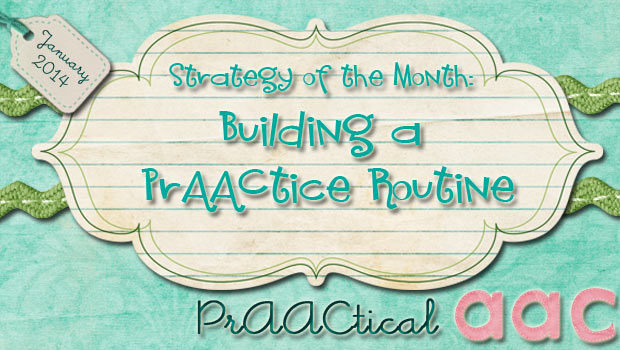
There’s an old joke about a tourist wandering around New York City in search of the famed musical venue that has been home to countless performances of classical music. After walking in circles, he finally stops a resident to ask for directions, “How do you get to Carnegie Hall?” “Practice, practice, practice,” was the reply. And so it is with AAC. No matter what their age or disabling condition, there is one thing that every AAC learner needs: Practice. A lot of it. It takes a lot of daily practice for people learning to use AAC in order for them to: Become fluent with their AAC systems Build their vocabularies Develop their syntactic skills Respond more quickly Communicate less effortfully As we’ve said before, we tend to like things that we’re good at and things that are relatively easy for us. It time and a lot practice for some of... [Read More...]
December 2, 2013
by Robin Parker -
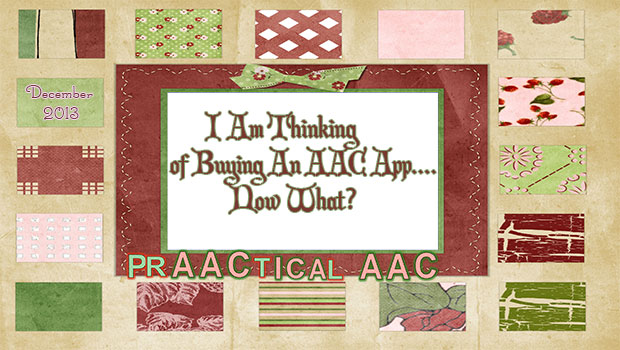
This may be the time of year you are thinking of adding AAC apps to your assessment collection or are planning on getting one for an individual learner or for a group of learners. As you consider which app or apps to purchase, here are some feature considerations as well as some options for learning about the apps. **For any individual learner, a specific AAC evaluation by a qualified speech-language pathologist is always highly recommended. Language Features Core word approach to language learning Functional language approach to language learning Visual scene approach to language learning Pre-made communication displays or create your own Communication Functions (requesting, Choicemaking, commenting, complaining, etc.) Sentence building options Options for morphological learning Allows for full communication including requests, saying no, greetings,ventings, and sharing of information Comprehensive language learning Small Talk Single or sequenced messages Technical Features Customization level Platform Options (iOS, Android, Computer) Digitized (recorded) vs... [Read More...]









